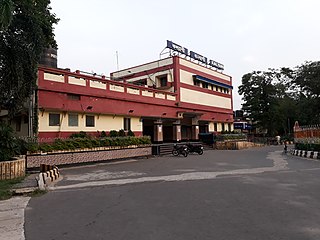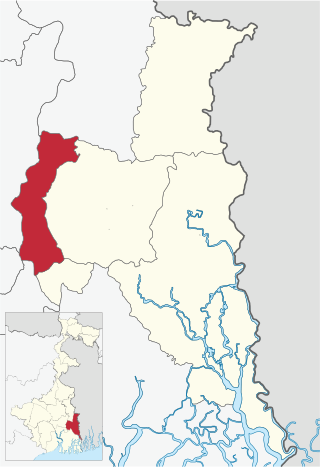
West Bengal is a state in the eastern portion of India. It is situated along the Bay of Bengal, along with a population of over 91 million inhabitants within an area of 88,752 km2 (34,267 sq mi) as of 2011. The population estimate as of 2023 is 102,552,787. West Bengal is the fourth-most populous and thirteenth-largest state by area in India, as well as the eighth-most populous country subdivision of the world. As a part of the Bengal region of the Indian subcontinent, it borders Bangladesh in the east, and Nepal and Bhutan in the north. It also borders the Indian states of Jharkhand, Odisha, Bihar, Sikkim and Assam. The state capital is Kolkata, the third-largest metropolis, and seventh largest city by population in India. West Bengal includes the Darjeeling Himalayan hill region, the Ganges delta, the Rarh region, the coastal Sundarbans and the Bay of Bengal. The state's main ethnic group are the Bengalis, with the Bengali Hindus forming the demographic majority.

Kolkata is the capital and largest city of the Indian state of West Bengal. It lies on the eastern bank of the Hooghly River, 80 km (50 mi) west of the border with Bangladesh. It is the primary financial and commercial center of eastern and northeastern India. Kolkata is the seventh most populous city of India with an estimated city proper population of 4.5 million (0.45 crore). It is the centre of the Kolkata Metropolitan Region, one of the most populous metropolitan area in the world with a population of over 15 million residents. Kolkata is the de facto cultural capital of India and historically and culturally significant city in the historic region of Bengal. It is the second largest Bengali-speaking city in the world. It has the highest number of nobel laureates among all cities in India.

The University of Calcutta is a public state university located in Kolkata, West Bengal, India. It has 151 affiliated undergraduate colleges and 16 institutes in Kolkata and nearby areas. It was established on 24 January 1857 and is the oldest multidisciplinary university of Indian Subcontinent and South East Asian Region. Today, the university's jurisdiction is limited to a few districts of West Bengal, but at the time of its establishment it had a catchment area ranging from Kabul to Myanmar. Within India, it is recognized as a "Five-Star University" and accredited an "A++" grade by the National Assessment and Accreditation Council (NAAC).

Jadavpur is a southern neighbourhood of Kolkata in the district of Kolkata of West Bengal, India. Jadavpur is one of the important junctions in South Kolkata. Jadavpur University and a number of research institutes of national and international repute are located in Jadavpur.

The West Bengal National University of Juridical Sciences is a National Law University (NLU) located in Bidhannagar, Kolkata, West Bengal, India. In 2023, it was ranked 4th among law colleges in India by National Institutional Ranking Framework and 2nd by India Today. It comes under the exclusive chancellorship and purview of the [Chief Justice of India].
Narendrapur is a neighbourhood in the Rajpur Sonarpur of the South 24 Parganas district in the Indian state of West Bengal. It is a part of the area covered by the Kolkata Metropolitan Development Authority (KMDA).

Medical College, Kolkata, also known as Calcutta Medical College, is a public medical college and hospital located in Kolkata, West Bengal, India. It is one of the oldest existing hospitals in Asia. The institute was established on 28 January 1835 by Lord William Bentinck during British Raj as Medical College, Bengal. It is the second oldest medical college to teach Western medicine in Asia after Ecole de Médicine de Pondichéry and the first institute to teach in English language. The college offers MBBS degree after five and a half years of medical training.

The Calcutta National Medical College and Hospital (CNMCH), colloquially known as Chittaranjan Hospital, is a public medical college and hospital located in Kolkata, West Bengal, India. It was established by the amalgamation of the National Medical Institute and Calcutta Medical Institute.

Bidhannagar is a city of the Indian state of West Bengal. The population within city limits was 2,18,323 at the 2011 census, it has increased since 2001 census. After a successful extension of the city limits in Jun 2015, Bidhannagar's population increased to 6.7 lakhs residents. It is now the fourth-most populous city in West Bengal, after Kolkata, Howrah and Asansol.
Education in West Bengal is provided by both the public sector as well as the private sector. The modern education system was developed by the British missionaries and the Indian social reformists. West Bengal has many institutes of higher education like –Indian Institute of Technology Kharagpur, Marine Engineering and Research Institute, Jadavpur University, Indian Institute of Management Calcutta, Indian Institute of Engineering Science and Technology, Shibpur, Indian Institute of Science Education and Research, Kolkata, National Institute of Technology, Durgapur, Indian Institute of Information Technology, Kalyani, Indian Statistical Institute, West Bengal University of Health Sciences, University of North Bengal and University of Calcutta.

Kalyani is a planned urban city in Nadia district in the Indian state of West Bengal. It is also a municipality and Community Development Block in Nadia. It is located around 50 kilometres from Kolkata — the capital of West Bengal. Kalyani is the administrative headquarters of Kalyani subdivision. It resides on the eastern banks of Hooghly River, and is part of the Kolkata Metropolitan Development Authority (KMDA).

The Durbar Mahila Samanwaya Committee, or simply Durbar, is a collective of 65,000 sex workers in West Bengal. Established on 15 February 1992, in Sonagachi, the largest red-light district in Kolkata, West Bengal, India with estimated 11,000 sex workers, Durbar has been working on women's rights and sex workers' rights advocacy, anti-human trafficking and HIV/AIDS prevention. The Durbar states that its aims are the challenging and altering of the barriers that form the everyday reality of sex workers' lives as they relate to their poverty or their ostracism. Durbar runs 51 free clinics for sex workers across West Bengal, with support from organisations such as the Ford Foundation and the National AIDS Control Organisation (NACO), who also help Durbar in its initiatives like networking, rights protection and creating alternative livelihood for sex workers.

The Maulana Abul Kalam Azad Institute of Asian Studies is an autonomous research institute based in Kolkata. It is funded by the Ministry of Culture of the Government of India. It was founded on 4 January 1993. The foundation stone of the institute was laid where the new building now stands on 12 March 1993. It is devoted to the study of the life and works of Maulana Abul Kalam Azad, the eminent nationalist leader and India's first education minister, after whom it is named, and to the furtherance of Area Studies, with special reference to South Asia, Central Asia and West Asia, especially dealing with social, cultural, economic, political and administrative developments in Asia from the nineteenth century to the present. M.Phil.- and Ph.D.-level students of the University of Calcutta, Jadavpur University and Jawaharlal Nehru University, New Delhi are also associated with it.

Bidhannagar subdivision is an administrative subdivision of the North 24 Parganas district in the Indian state of West Bengal. After transferring Rajarhat-Gopalpur Municipality and Rajarhat to Bidhannagar subdivision, Bidhannagar subdivision's total area becomes 141.37 sq km, population becomes 808,251 and density becomes 5,700/sq km.

Barrrackpore subdivision is an administrative subdivision of the North 24 Parganas district in the Indian state of West Bengal.

Institute of Post-Graduate Medical Education and Research and Seth Sukhlal Karnani Memorial Hospital, colloquially known as P.G. Hospital, is a public medical college and hospital located in Kolkata, India. It is a national research institute.

Sealdah is a neighbourhood of Central Kolkata in Kolkata district in the Indian state of West Bengal.

R. G. Kar Medical College and Hospital is a public medical college and hospital in Shyambazar, Kolkata, West Bengal, India. It was established in 1886 to ensure self-sufficiency (Swaraj) in medical education and services in the colonial era. It was under University of Calcutta from 1916 to 2003 and affiliated to West Bengal University of Health Sciences when it was established in 2003. R.G. Kar Medical College and Hospital completed 100 years of its service in 2016. This college is a co-educational institution that is recognized by the MCI and affiliated with the West Bengal University of Health Sciences.
Bishnupada Mukerjee or Bishnupada Mukhopadhyaya was an Indian pharmacologist and orthopedic surgeon, known for his contributions in the fields of pharmacological research and standardization of drugs in India. The Government of India honoured him in 1962, with the award of Padma Shri, the fourth highest Indian civilian award for his services to the nation.

The University College of Science, Technology and Agriculture are two of five main campuses of the University of Calcutta (CU). The college served as the cradle of Indian Sciences by winning the Nobel Prize in Physics in 1930 and many fellowships of the Royal Society London.


















